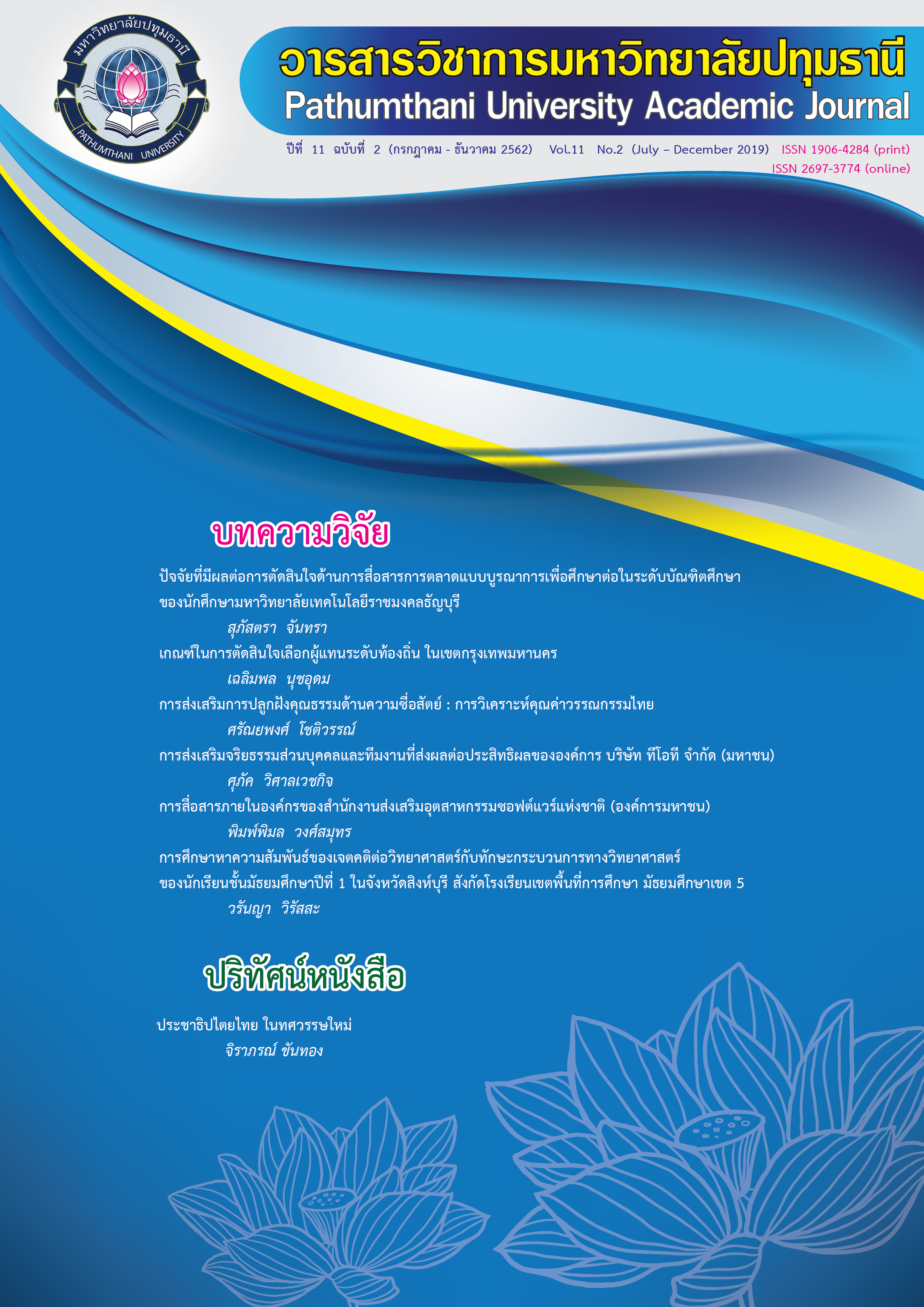Organizational Communication of the Software Industry Promotion Agency (Public Organization)
Keywords:
Organizational Communication, Software Industry Promotion Agency (Public Organization), Forms of CommunicationAbstract
The objectives of this research were to study 1) the forms of organizational communication used at the Software Industry Promotion Agency (SIPA); 2) SIPA employees’ satisfaction with the organizational communication; 3) SIPA employees’ demand for organizational communication; 4) problems with SIPA’s organizational communication; 5) the relationships between SIPA employees’ demographic factors and their level of satisfaction with the organizational communication; and 6) the relationships between SIPA employees’ demographic factors and their demand for organizational communication. This was a survey research. The study population and sample population was 96 employees of SIPA (a public organization), including 3 administrators. The sample population was chosen through purposive sampling. Research tools employed consisted of a questionnaire and an interview form. Data were collected by administering a questionnaire and through in-depth interviews. Quantitative data were analyzed using the statistics of frequency, percentage, mean, standard deviation, t-test, ANOVA, and Fisher’s Exact Test. Qualitative data were analyzed using descriptive analysis. The results showed that 1) organizational communication within SIPA were mostly formal communications, two-way communications, and inter-departmental communications using the media of telephone, e-mail, Line, Facebook and the intranet. 2) The samples were highly satisfied with organizational communication. 3) The samples had a high level of demand for organizational communication. 4) Problems with organizational communication were that news was sometimes not current, the media were not always modern, employees sometimes lacked skills for analyzing news and information and employees sometimes lacked skills for utilizing new media. 5) There were statistically significant relationships (p<0.05) between the demographic factors of sex and educational level and employees’ level of satisfaction with SIPA’s organizational communication. 6) There were statistically significant relationships (p<0.05) between the demographic factors of sex, age, educational level, work duties, length of time working at SIPA and employees’ level of demand for organizational communication.
References
2.จันทรา มังกรศักดิ์สิทธิ์. (2556). ความคิดเห็นของพนักงานต่อการสื่อสารองค์การ: กรณีศึกษาโรงพยาบาลนนทเวช. วิทยานิพนธ์ปริญญาบริหารธุรกิจมหาบัณฑิต. มหาวิทยาลัยธุรกิจบัณฑิตย์.
3.เบญจพร ยิฐธรรม. (2553). ความสัมพันธ์ระหว่างพฤติกรรมการติดต่อสื่อสาร และการสนับสนุนทางสังคมในองค์การ กับขวัญกำลังใจในการปฏิบัติงานกรณีศึกษา ข้าราชการสังกัดกระทรวงอุตสาหกรรม. วิทยานิพนธ์ปริญญาวิทยาศาสตรมหาบัณฑิต. สถาบันบัณฑิตพัฒนบริหารศาสตร์.
4.เบญจวรรณ แจ่มจำรุญ. (2557). ปัจจัยบรรยากาศในการสื่อสารภายในองค์กร กระบวนการในการสื่อสาร และสื่อสังคมออนไลน์ส่งผลต่อประสิทธิภาพในการสื่อสารภายในองค์กรของบริษัทเอกชนในเขตกรุงเทพมหานคร. วิทยานิพนธ์ปริญญาบริหารธุรกิจมหาบัณฑิต. มหาวิทยาลัยกรุงเทพ.
5.ธัญญารัตน์ อินทร์เมือง. (2555). ประสิทธิภาพการสื่อสารภายในองค์กรกับความสำเร็จในการดำเนินงานของมหาวิทยาลัยนเรศวร. วิทยานิพนธ์ปริญญาบริหารธุรกิจมหาบัณฑิต. มหาวิทยาลัยนเรศวร.
6.ปัทมา สมพรชัยกิจ. (2556). การสื่อสารภายในองค์การของสำนักเทศกิจ กรุงเทพมหานคร. วิทยานิพนธ์ปริญญาวารสารศาสตร์และสื่อสารมวลชนมหาบัณฑิต.มหาวิทยาลัยธรรมศาสตร์.
7.ภัทราวรรณ แก้วมะยม. (2554). รูปแบบการสื่อสารภายในองค์การและความพึงพอใจต่อการสื่อสารภายในองค์การของพนักงานเจ้าหน้าที่สานักงานเลขาธิการคุรุสภา. วิทยานิพนธ์ปริญญาวารสารศาสตร์มหาบัณฑิต. มหาวิทยาลัยธรรมศาสตร์.
8.ภัสวลี นิติเกษตรสุนทร. (2550). ความรู้เบื้องต้นเกี่ยวกับการสื่อสารและพฤติกรรมการสื่อสาร ในเอกสารการสอนชุดวิชาทฤษฎีและพฤติกรรมการสื่อสาร. นนทบุรี: สำนักพิมพ์มหาวิทยาลัยสุโขทัยธรรมาธิราช.
9.ยุบล เบ็ญจรงค์กิจ. (2542). การวิเคราะห์ผู้รับสาร. กรุงเทพฯ: คณะนิเทศศาสตร์ จุฬาลงกรณ์มหาวิทยาลัย.
10.รสชงสพร โกมลเสวิน. (2554). พฤติกรรมการสื่อสารองค์กร ใน เอกสารการสอนชุดวิชาทฤษฎีและพฤติกรรมการสื่อสาร หน่วยที่ 9. นนทบุรี: สำนักพิมพ์มหาวิทยาลัยสุโขทัยธรรมาธิราช.
11.รุ่งรัตน์ ชัยสำเร็จ. (2558). การสื่อสารในองค์กร. กรุงเทพฯ: โรงพิมพ์แห่งจุฬาลงกรณ์มหาวิทยาลัย.
12.ศรีสุนันท์ อนุจรพันธุ์. (2552). พฤติกรรมด้านการสื่อสารภายในองค์กรที่มีผลต่อความพึงพอใจของพนักงานซึ่งส่งผลต่อการพัฒนาองค์กร กรณีศึกษา บริษัท บิซิเนส ออนไลน์ จำกัด (มหาชน). วิทยานิพนธ์ปริญญาบริหารธุรกิจมหาบัณฑิต. มหาวิทยาลัยรังสิต.
Downloads
Published
How to Cite
Issue
Section
License
บทความที่ได้รับการตีพิมพ์เป็นลิขสิทธิ์ของวารสารมหาวิทยาลัยปทุมธานี
ข้อความที่ปรากฎในบทความแต่ละเรื่อง เป็นความคิดเห็นส่วนตัวของผู้เขียน กองบรรณาธิการไม่จำเป็นต้องเห็นด้วยเสมอไป และไม่มีส่วนรับผิดชอบใด ๆ ถือเป็นความรับผิดชอบของผู้เขียนแต่เพียงผู้เดียว



